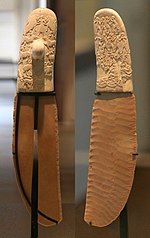Pisau Gebel el-Arak

Pisau Gebel el-Arak, juga Pisau Jebel el-Arak, merupakan pisau gading dan batu yang berasal dari periode Naqada II prasejarah Mesir (3500—3200 SM), menunjukkan pengaruh Mesopotamia. Pisau itu dibeli pada 1914 di Kairo oleh Georges Aaron Bénédite untuk Museum Louvre, di mana sekarang dipajang di sayap Sully, ruang 20.[1][2] Pada saat pembeliannya, gagang pisau tersebut diduga oleh penjual telah ditemukan di situs Gebel el-Arak, tetapi saat ini diyakini berasal dari Abydos.
Referensi
- ^ Mark, Samuel (2006). From Egypt to Mesopotamia: a Study of Predynastic Trade Routes (edisi ke-new). Texas A & M University Press. ISBN 978-1585445301. .
- ^ Conference, William Foxwell Albright Centennial (1996). The Study of the Ancient Near East in the Twenty-first Century: The William Foxwell Albright Centennial Conference (dalam bahasa Inggris). Eisenbrauns. hlm. 10. ISBN 978-0-931464-96-6.
Bacaan selanjutnya
- Grimal, Nicolas-Christophe (1992). A History of Ancient Egypt. Oxford: Blackwell. hlm. 29ff. ISBN 0-631-19396-0.
Pranala luar

Wikimedia Commons memiliki media mengenai Gebel el Arak Knife.
- The Gebel el Arak knife, Images on the backside of the handle
- The Gebel el Arak knife, Depiction of a predynastic battle scene
- A complete narrative of the events portrayed on the Gebel el-Arak knife.
- (dalam bahasa Prancis) Poignard "du Gebel el-Arak", official site of the Louvre.










